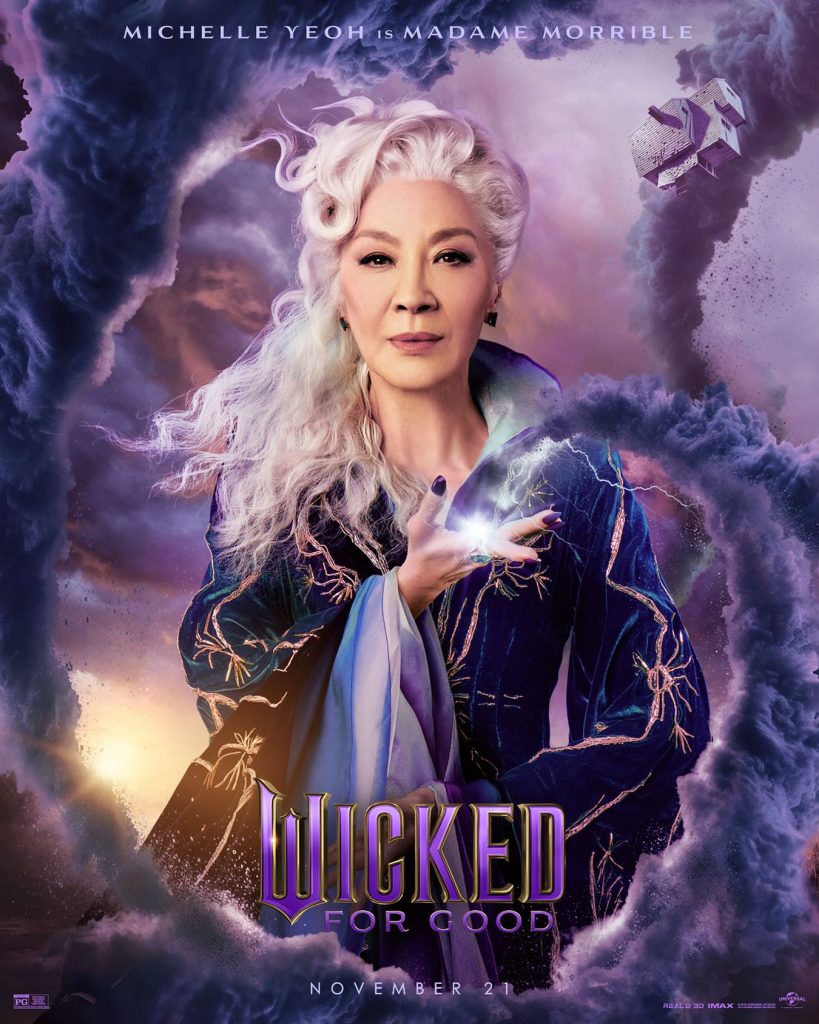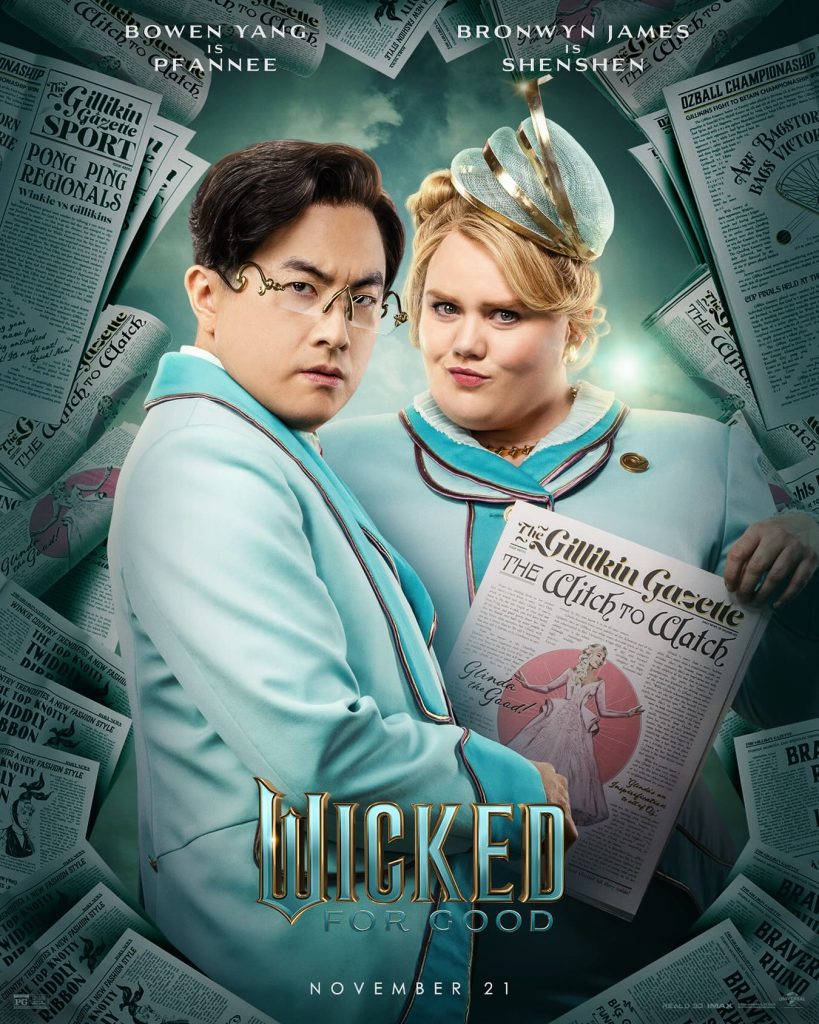After the world’s longest intermission, the cinematic second act of Wicked is here in For Good. David Ho reviews the highly anticipated musical adventure
It’s no easy nor enviable task to roll out Wicked: For Good. After all, the world has waited a year for the second act. It’s especially difficult when one has to top the climax of “Defying Gravity”, the anthem that ended the first act. But director Jon M. Chu is back with the citizens of Oz to conclude the story. It’s good to see them, isn’t it?
A quick recap if needed, as Wicked: For Good does not provide it. Witches and unlikely friends Elphaba (Cynthia Erivo) and Glinda (Ariana Grande, credited under her full Grande-Butera surname as tribute to her little self) discover that the ruler of Oz is nothing but a “carnie” charlatan. The Wonderful Wizard of Oz (Jeff Goldblum) is a mere human who dazzles with clever machinations.
But worst of all, he is a puppet for Madame Morrible (Michelle Yeoh), who is a Shiz University staff by day and political power broker 24/7. The two antagonists are oppressing the animal citizens of Oz and taking away their ability to speak. Elphaba and Glinda part ways upon this discovery. While Elphaba is determined to reveal the truth, Glinda is eager to just maintain the status quo.

Mild spoilers ahead
Wicked: For Good drops us in after some time has passed since the witches’ gravity-defying farewell. Elphaba has now been tarred as the ‘Wicked Witch of the West’, as she fights for animal rights and liberation. She attacks the slavery-led construction of the Yellow Brick Road and takes on Oz military, like a green-skinned Batman on a broom. Her action scenes are almost akin to a superhero movie at times, a stark contrast from the previous outing.
Meanwhile, the Barbie-esque Glinda has been fully sucked into the political machinations of Oz. She now stands as a beacon of hope for the citizens, like an Evita in pink. Her one-sided romance with the dashing Fiyero (People’s sexiest man alive of 2025, Jonathan Bailey), now an army captain, is used to distract the sheeple of Oz. Glinda loves Fiyero but his heart belongs to Elphaba, a love triangle that complicates things between the former schoolmates.

At the same time, another love triangle has imploded. Elphaba’s spoiled brat sister Nessarose (Marissa Bode) has become governor of Munchkinland, after the death of their father. She may have power and influence, but not the ability to walk or the heart of Boq Woodsman (Ethan Slater). After Boq learns of Glinda’s engagement, he tries to leave Nessarose to shoot his final shot with Glinda. But in a Trump-like move, she uses immigration and border control to stop him from getting away.
With animals fleeing Oz and even believing the propaganda about her, a desperate Elphaba turns to Nessarose for help. But her sister makes the reunion all about herself and uses Elphaba’s spell book to punish Boq. This leads to an unfortunate sequence of events that leads to Elphaba eventually losing all those dear to her. In turn, this creates the happenings in The Wizard of Oz.


#review
Wicked has many layers. The broader story of anti-fascism and history as propaganda is still intact here, and a timely reminder for contemporary audiences. It reframes the classic The Wizard of Oz as being the story from Dorothy’s POV or the PR version told by Glinda, depending on your interpretation. Basically, it is to Oz lore what Untucked is to RuPaul’s Drag Race. If you’re not watching Untucked, you’re only getting half the story.
But the heart of Wicked’s story is that of the love between two unlikely friends. In the first act, we see how Elphaba and Glinda connect, despite being polar opposites. The gap is widened in this film, as they now stand on different ends of the political spectrum. Elphaba’s strong convictions and radical acts now contrasts the slow corruption behind Glinda’s cotton candy sweet facade, especially after being exposed to the perks of her job.

One of the criticisms that Wicked: For Good has received is allowing a man to come between the witches and for them to be fighting over him. However, we feel that it speaks to the underlying competitiveness that sometimes poisons sisterhood. The dissolution of the friendship hits hard. It also leads to a hilarious highlight and the emotional gut punches that forms the core of For Good.
We also dig how Jon M. Chu handled some of the iconic Oz characters and environment. Boq as the Tin Man is worthy of a horror film of his own, while the Scarecrow had us at “hay”. Despite the second act being more CGI heavy, the world building still feels wonderful, pun intended. But the CGI for a de-aged Jeff Goldblum should have been left on the cutting room or in The Substance.

It pains us to write this. But Michelle Yeoh’s Madame Morrible remains Wicked’s biggest weak point, as it was in act one. Her stiff and stern take feels like an extended version of Eleanor Young, her character in Crazy Rich Asians, which was her previous collaboration with Chu. Mix that with a dash of Effie Trinket from The Hunger Games and you get what we end up with.
We understand singing is not Yeoh’s forte, being that this is her first musical work. But the fact that the few singing lines she has in Wicked: For Good is flat and off beat is shocking. It should have at least been fixed in post-production, much like how Emma Watson was auto-tuned to the woods for the live action Beauty and the Beast. We adore Yeoh, but the role should have gone to someone who could have done more with it.

But the spotlight is mainly on Erivo and Grande-Butera. The duo deliver the vocals with passion and their lines with emotion, including in new songs like “The Girl in the Bubble” and “No Place Like Home”. The two have been accused of laying it on too thick during their press tour. But on screen, there is no denying the easy chemistry they share. In the cinema, we could hear sobs as the two review their friendship and impact on each other in the song “For Good”. Not a typical thing we see with Hong Kong’s usually stoic audience.

The pacing in the final quarter does feels a bit rushed, as we run through key plot points too quickly. We get but a glimpse of Dorothy, left faceless to allow us to imagine her as Judy Garland. The ‘final showdown’ between Dorothy and the Wicked Witch of the West is done in silhouette form. It’s done that way in stage productions, and perhaps to keep proceedings family friendly. But it is a missed opportunity to further flesh out stage limitations out in film.

After disasters like Cats, who can say if musical movies have been changed for the better? But at the very least, we will say that Wicked has changed us. For good.
Verdict: The second act of Wicked has been well worth the year-long wait. We can see future generations enjoying both acts for some time to come. A new classic has arrived and we are obsessulated.






